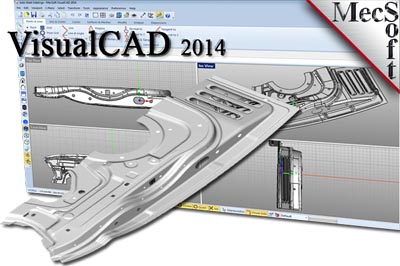
MecSoft Europe GmbH offers a range of easy-to-use, powerful and affordable software for CNC machining. The high-quality and yet budget-friendly portfolio includes solutions for a variety of industries such as mold and die, aviation and aerospace, automotive, rapid prototyping and wood processing industry.
VisualCAD/CAM is MecSoft's standalone package. It features the easy-to-use CAD program VisualCAD, which acts as the base platform for each of the four CAM modules. The milling module VisualMILL includes 2-½-, 3-, 4- and 5-axis toolpath functionality for CNC machining. A large variety of free post-processors and an open post-processor generator are available free of charge. The module VisualTURN is a powerful 2-axis programming system for turning centers and enables roughing, finishing, V-carving, threading, parting and drilling. The nesting module VisualNEST is suited to optimally arrange and position geometric shapes onto sheets of stock material. The fourth module VisualART is used to convert artwork into geometry for later machining.
In addition to the standalone solution VisualCAD/CAM MecSoft offers a series of CAD plug-ins and enables users to work in their familiar user interface. RhinoCAM, a plug-in for Rhinoceros, offers the same features like the standalone version and includes the four modules for milling, turning, nesting and art as well. Other popular plug-ins are VisualCAM for Solidworks and VisualCAM for Geomagic that include the milling module and turning modules.
"MecSoft offers an enormous range of high-quality software solutions for small money," says Ulrich Oehler, CEO MecSoft Europe. "Our products are available in various configurations so that that we can offer the right solution for individual requirements, both simple and complex. Flexible version upgrades are always available to easily fit increasing requirements."
Contact Details
Related Glossary Terms
- centers
centers
Cone-shaped pins that support a workpiece by one or two ends during machining. The centers fit into holes drilled in the workpiece ends. Centers that turn with the workpiece are called “live” centers; those that do not are called “dead” centers.
- computer numerical control ( CNC)
computer numerical control ( CNC)
Microprocessor-based controller dedicated to a machine tool that permits the creation or modification of parts. Programmed numerical control activates the machine’s servos and spindle drives and controls the various machining operations. See DNC, direct numerical control; NC, numerical control.
- computer-aided design ( CAD)
computer-aided design ( CAD)
Product-design functions performed with the help of computers and special software.
- computer-aided manufacturing ( CAM)
computer-aided manufacturing ( CAM)
Use of computers to control machining and manufacturing processes.
- gang cutting ( milling)
gang cutting ( milling)
Machining with several cutters mounted on a single arbor, generally for simultaneous cutting.
- milling
milling
Machining operation in which metal or other material is removed by applying power to a rotating cutter. In vertical milling, the cutting tool is mounted vertically on the spindle. In horizontal milling, the cutting tool is mounted horizontally, either directly on the spindle or on an arbor. Horizontal milling is further broken down into conventional milling, where the cutter rotates opposite the direction of feed, or “up” into the workpiece; and climb milling, where the cutter rotates in the direction of feed, or “down” into the workpiece. Milling operations include plane or surface milling, endmilling, facemilling, angle milling, form milling and profiling.
- parting
parting
When used in lathe or screw-machine operations, this process separates a completed part from chuck-held or collet-fed stock by means of a very narrow, flat-end cutting, or parting, tool.
- threading
threading
Process of both external (e.g., thread milling) and internal (e.g., tapping, thread milling) cutting, turning and rolling of threads into particular material. Standardized specifications are available to determine the desired results of the threading process. Numerous thread-series designations are written for specific applications. Threading often is performed on a lathe. Specifications such as thread height are critical in determining the strength of the threads. The material used is taken into consideration in determining the expected results of any particular application for that threaded piece. In external threading, a calculated depth is required as well as a particular angle to the cut. To perform internal threading, the exact diameter to bore the hole is critical before threading. The threads are distinguished from one another by the amount of tolerance and/or allowance that is specified. See turning.
- toolpath( cutter path)
toolpath( cutter path)
2-D or 3-D path generated by program code or a CAM system and followed by tool when machining a part.
- turning
turning
Workpiece is held in a chuck, mounted on a face plate or secured between centers and rotated while a cutting tool, normally a single-point tool, is fed into it along its periphery or across its end or face. Takes the form of straight turning (cutting along the periphery of the workpiece); taper turning (creating a taper); step turning (turning different-size diameters on the same work); chamfering (beveling an edge or shoulder); facing (cutting on an end); turning threads (usually external but can be internal); roughing (high-volume metal removal); and finishing (final light cuts). Performed on lathes, turning centers, chucking machines, automatic screw machines and similar machines.






